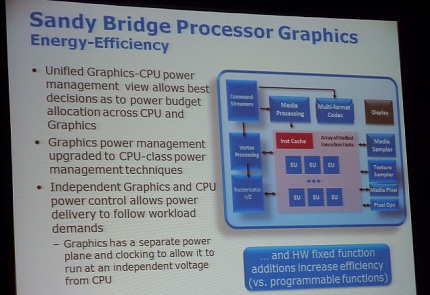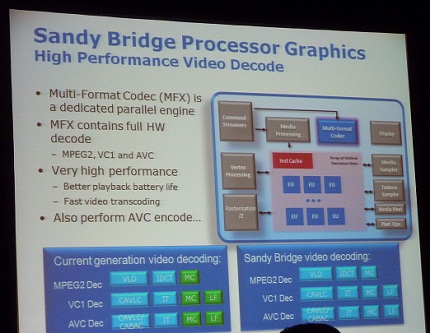Monolithic silicon
The second-generation Core design brings together the CPU, GPU and memory controller on one piece of silicon, and Intel is using this integration to boost the performance of its new chips. In particular, the GPU portion - which is on a different piece of silicon on select Core i3, i5 and i7 processors shipping right now - is being overhauled in Sandy Bridge to provide double the performance of current-generation Intel HD Graphics.

Being an IGP, Intel is interested in reducing power-draw while maintaining reasonable performance. To this end, it is providing more fixed-function units in Sandy Bridge than in previous generation IGPs. While these costs die space and transistors, the chip company believes the trade-off between running code on dedicated hardware (as opposed to through programmable shaders) is worth the sacrifice.
Beefy shaders
The IGP is to have up to 12 execution units (shaders). This is the same as the current generation HD Graphics, but Intel reckons that the benefits of increased clockspeed, better cache support, and more registers means that the new IGP graphics will be, on average, twice as fast as those found in current Core i3 and Core i5 processors.
Intel makes a big deal about the benefits arising from integrating the GPU on the same die as the CPU, citing reduced latencies, benefits of accessing on-chip cache, and finer control over the IGP's Turbo Boost features. We reckon Sandy Bridge's IGP will be competitive with low-end discrete graphics cards - Radeon HD 5450, for example.

Video engine malarkey
But perhaps the most innovative part of Sandy Bridge graphics is the inclusion of dedicated logic for video decoding (MPEG2, VC1, H.264) and transcoding. Akin to the UVD block in AMD hardware, the Multi-Format Codec uses a fixed-function architecture to speed-up computationally-intensive video processing, working in tandem with the GPU's shaders.
Hammering home the performance improvement from the video transcoding engine, Intel demonstrated it transcoding high-def to the iPhone-friendly format. Sandy Bridge gave an 'equivalent' Core i7 chip a good whipping, beating it by a comprehensive margin.
From what we saw at IDF, Intel's next-generation integrated graphics should provide double the performance of current IGPs. Appreciating that this will not be nearly enough oomph to power new games with decent image-quality settings - you'll always need a discrete video card for that - Sandy Bridge's IGP looks promising.













